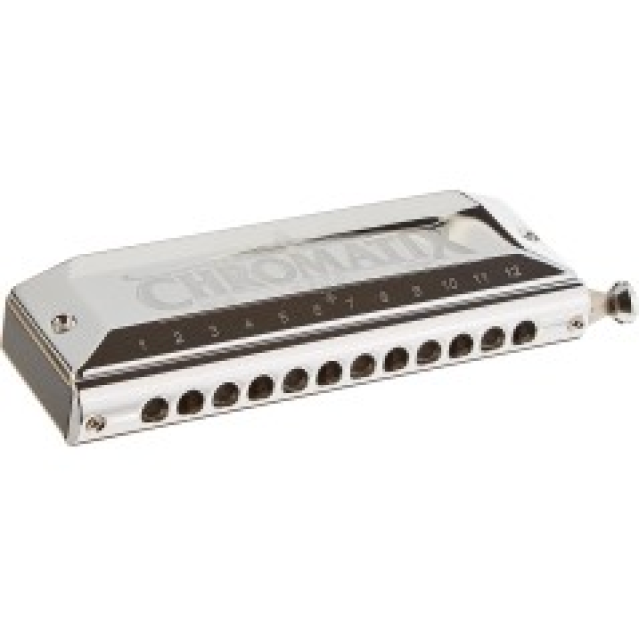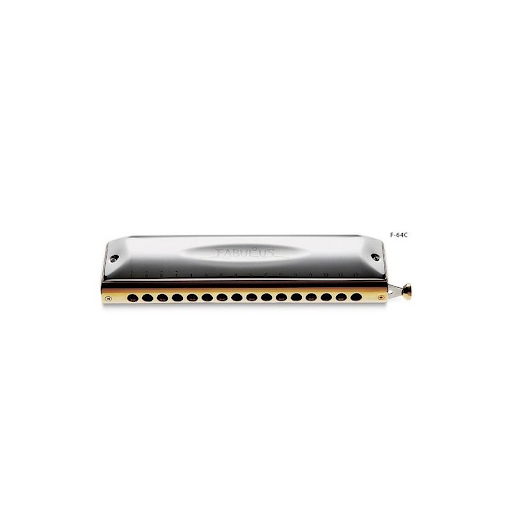Oct
30,
2023
Did you know that the harmonica has been around for centuries, yet it's one of the most underappreciated instruments out there? It's true. While ...

Welcome to our captivating blog, where we embark on a musical journey delving into "The Evolution of Chromatic Harmonicas: A Historical Overview." In this enriching exploration, we will uncover the fascinating story behind these remarkable instruments and their impact on the world of music.
Firstly, let's understand what sets chromatic harmonicas apart. Defined by their ingenious slide mechanism, these harmonicas offer a complete chromatic scale, allowing musicians to play all the sharps and flats effortlessly. With such versatility, it's no wonder they have carved a unique place in the hearts of musicians and listeners alike.
As we travel back in time, we'll witness the early roots of chromatic harmonicas and the pioneering players who paved the way for their development. We'll witness the rise of chromatic harmonicas, their growing popularity across various music genres, and the pivotal milestones that shaped their design.
Join us as we unravel the stories of legendary harmonica virtuosos and their profound impact on music history. From jazz and blues to classical and contemporary, we'll explore how chromatic harmonicas have left an indelible mark on different musical landscapes.
The early roots of chromatic harmonicas trace back to a captivating era of musical innovation and creativity. It was a time when harmonicas like the Hohner Chrometta 8 were undergoing significant development, and musicians sought to unlock new possibilities in their performances.
Pioneering players experimented with various chromatic harmonicas like the iconic Hohner Super 64X to achieve greater musical versatility. Their pursuit of new sounds and techniques pushed the boundaries of harmonica playing.
Development and Innovation in Harmonicas: Before the advent of chromatic harmonicas, diatonic harmonicas dominated the music scene. However, musicians craved more notes and the ability to play all the sharps and flats seamlessly. This desire for musical versatility fueled the exploration of new designs.
First Steps Towards Chromatic Functionality: In this period of musical experimentation, the first rudimentary attempts at achieving chromatic functionality emerged. Inventors and musicians experimented with various mechanisms and layouts to create harmonicas that could produce all 12 notes of the chromatic scale.
Pioneering Players and Their Contributions: Pioneering musicians, such as those playing Suzuki chromatic harmonicas, played a pivotal role in the development and popularization of these innovative instruments. Their relentless pursuit of new sounds and techniques pushed the boundaries of harmonica playing.
The evolution of chromatic harmonicas has been marked by significant advancements in design and technology, making them versatile and beloved musical instruments. Among the notable brands, Hohner has played a pivotal role in driving the rise of chromatic harmonicas with timeless models like the Hohner Chromonica 64/280. Hohner's improvements in air-tightness and reed responsiveness, as seen in reed plates like the Hohner Xpression, have enhanced playability and tonal range.
Suzuki has been at the forefront of introducing innovative features in chromatic harmonicas. They have made substantial improvements in air-tightness and reed responsiveness, enhancing the instrument's overall playability and tonal range. The incorporation of precision-engineered slide mechanisms ensures smooth and effortless transitions between notes, enabling players to explore complex melodies with ease. Suzuki's commitment to excellence in craftsmanship has earned them a reputation for producing harmonicas with exceptional build quality and durability.
The rise of Suzuki chromatic harmonicas can be attributed to their growing popularity in the music industry. Renowned harmonica players worldwide have embraced Hohner chromatic harmonicas like the versatile Hohner CX12 Jazz for their reliability and outstanding sound quality. The popularity of Hohner chromatic harmonicas has made the brand a go-to choice for professionals and enthusiasts. alike, further solidifying their position in the market.
C. Influence on Various Music Genres: Suzuki chromatic harmonicas have made a significant impact across diverse music genres. From enriching jazz and blues performances with soulful melodies to adding a touch of elegance to classical and orchestral compositions, Suzuki harmonicas have proved their versatility. Furthermore, their integration into contemporary and world music has opened up new creative possibilities, pushing the boundaries of harmonica playing.

The evolution of chromatic harmonicas has been marked by significant milestones that have shaped their design and capabilities. From the introduction of the slide mechanism to advancements in air-tightness and reeds, these developments have revolutionized the instrument, providing musicians with enhanced versatility and expression.
One of the key turning points in chromatic harmonica history was the introduction of the slide mechanism. This innovation, pioneered in Hohner models like the Hohner Chromonica 260 in the late 19th century, allowed players to access a full chromatic scale with the slide mechanism. The slide mechanism opened up new possibilities, enabling musicians to play in any key, making the chromatic harmonica a more versatile and valuable instrument.
Over time, Hohner recognized the demand for a broader range of keys and scales. They incorporated additional key options into chromatic harmonicas like the Hohner Chrometta 10. They incorporated additional key options into their chromatic harmonicas, allowing players to access a wider variety of musical genres and compositions. Musicians could now seamlessly switch between keys, making complex pieces easier to perform and opening doors to exploring various musical styles.
Advancements in air-tightness and reed technology significantly improved the overall playability and sound quality of chromatic harmonicas. Hohner invested in precision engineering for reed plates like the Hohner Ace 48, resulting in tighter seals and enhanced reed responsiveness. This not only made the instrument more reliable but also enriched the harmonica's tonal capabilities, making it a preferred choice for professional musicians and enthusiasts alike.

Chromatic harmonicas, especially renowned brands like Suzuki Chromatic Harmonicas, have made a significant impact across various music genres. Let's explore their roles in Jazz and Blues, Classical and Orchestral Music, as well as Contemporary and World Music.
In the world of Jazz and Blues, the Hohner Larry Adler 16 has become a staple instrument, adding expressive touches to performances. Jazz musicians love the chromatic harmonica for its ability to seamlessly play in all keys, making it perfect for improvisation. Its smooth glissandos and bending notes perfectly capture the essence of these genres, allowing players to convey emotions like never before. Legendary harmonica players like Toots Thielemans and Little Walter have showcased the instrument's versatility, inspiring generations of musicians.
Chromatic harmonicas have also found their place in the realm of Classical and Orchestral Music. With advancements in chromatic harmonica design and manufacturing, they now deliver impeccable intonation and tonal clarity. Composers and arrangers have integrated chromatic harmonicas into orchestral pieces, creating unique and memorable soundscapes. Suzuki Chromatic Harmonicas, with their precision engineering, have earned accolades for their seamless integration into classical ensembles, symphonies, and chamber music groups.
C. Contemporary and World Music: In Contemporary and World Music, the Suzuki Chromatic Harmonicas shine with their adaptability to various cultural influences and experimental styles. Musicians exploring fusion genres often turn to versatile Hohner chromatic harmonicas like the Hohner Chromonica 270 for their rich sound and versatility. The instrument's ability to produce microtonal notes and play in non-traditional scales expands the horizons of musical possibilities, attracting innovative artists who push the boundaries of conventional music.
When it comes to chromatic harmonicas, the market offers a wide array of options, each with its unique features and qualities. In this section, we'll delve into the world of chromatic harmonica models, with a focus on the renowned Suzuki Chromatic Harmonica series.
Suzuki is among the leading brands known for producing high-quality chromatic harmonicas. However, it's essential to compare different brands to make an informed choice. Look for reputable manufacturers with a history of producing reliable instruments. Consider factors like build quality, reputation, customer reviews, and pricing.
The Suzuki Chromatic Harmonica series boasts an impressive range of features and specifications. These harmonicas are crafted with precision, ensuring excellent air-tightness and responsiveness. They often come in various keys, allowing musicians to explore diverse musical genres. Additionally, Suzuki harmonicas are known for their smooth slide action, making playing effortless and enjoyable.
Choosing the right chromatic harmonica depends on your skill level, musical preferences, and budget. If you're a beginner, consider starting with a standard Suzuki model designed for easy playability and durability. Intermediate and advanced players may explore models with additional features for enhanced expression and tone versatility. Suzuki offers various series tailored to different playing styles, such as the Sirius, Fabulous, or SCX.
In conclusion, the historical journey of chromatic harmonicas has been nothing short of fascinating. From their humble beginnings and early innovations to becoming a prominent force in various music genres, these instruments have left an indelible mark on the world of music.
As we explored the evolution of chromatic harmonicas, we witnessed the significant contributions of legendary players and the advancements in design and technology that shaped their modern-day appeal. Brands like Suzuki, with their exceptional series, have stood out in providing musicians with top-quality instruments.
Whether you're a seasoned harmonica player or a curious beginner, the rich history and diverse options available today invite you to explore the world of chromatic harmonicas. Embrace the slide, experiment with different models, and let the melodies flow as you embark on a harmonious journey with these versatile and captivating instruments. Let the chromatic harmonica continue to charm and inspire generations to come.
Q: How does the slide mechanism work in a chromatic harmonica?
A: The slide button redirects airflow to different reed plates, enabling the player to access sharp or flat notes.
Q: What are some notable advancements in chromatic harmonica design over the years?
A: Advancements include improved air-tightness, reed response, and ergonomic features for enhanced playability and tone.
Q: How have chromatic harmonicas influenced different music genres?
A: Chromatic harmonicas have enriched various genres, from jazz and blues to classical and world music.
Q: Are chromatic harmonicas suitable for beginners, or should I start with a diatonic harmonica?
A: Beginners often start with diatonic harmonicas for simplicity, but chromatic harmonicas offer greater tonal range.
Q: Can I use chromatic harmonicas for playing traditional folk music?
A: Yes, chromatic harmonicas are versatile and can be used for traditional folk music as well.
Q: What are some famous musicians known for their mastery of chromatic harmonica?
A: Toots Thielemans, a jazz harmonica player from Belgium, is renowned for his exceptional skill.
Q: How can I maintain and care for my chromatic harmonica?
A: Regularly clean, store in a protective case, avoid extreme conditions, and handle the slide mechanism carefully.
Comments :